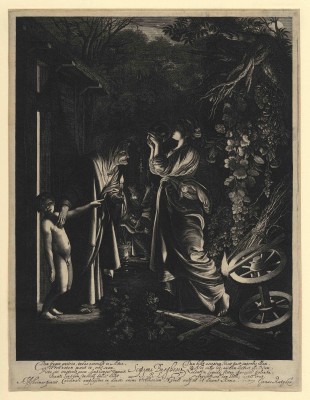HENDRICK GOUDT
1583 The Hague – Utrecht 1648

The Mocking of Ceres (after Adam Elsheimer) 1610
engraving; 326 x 252 mm (12 13/16 x 9 15/16 inches)
Dutuit 6; Weizsäcker vol. 2, p. 139, no. 19 first state (of two); Hollstein 5; Andrews,
p. 188 under no. 23; Jacoby, p. 219 under no. 25
Click images to toggle info
-
![HENDRICK GOUDT 1583 The Hague – Utrecht 1648 The Mocking of Ceres (after ADAM ELSHEIMER) 1610 engraving with engraving; 326 x 252 mm (12 13/16 x 9 15/16 inches) Dutuit 6; Weizsäcker vol. 2, p. 139, no. 19 first state (of two); Hollstein 5; Andrews, p. 188 under no. 23; Jacoby, p. 219 under no. 25 WATERMARK Strasburg lily and shield with bend PROVENANCE P. & D. Colnaghi & Co., London (their stock nos. in pencil on verso C29213 and 33841) A very fine impression; in small tear in the lower left margin with an old repair; pale mat stain in the margins; with small margins beyond the platemark all round. This is one of the two plates Goudt engraved in Rome after compositions by Adam Elsheimer. The original painting that must have served as the model for Elsheimer’s own etching of this subject (known only in a unique impression in the Kupferstichkabinett of the Hamburger Kunsthalle; Jacoby, p. 85, fig. 65) as well as for Goudt’s print, is thought to be lost. It was formerly believed to be the version in the Museo del Prado, Madrid, which shows the scene in reverse, an idea disputed by Keith Andrews (Andrews, pp. 187ff., no. 23). The story illustrated here is taken from Ovid’s Metamorphoses (V.446−461) and paraphrased in the verses of the poet and diplomat Janus Rutgers engraved below the print. While searching the earth for her daughter Proserpina, who had been abducted by Pluto, Ceres quenched her thirst at the house of an elderly peasant woman. Ceres drank the water so greedily that she was mocked by Stellio, the young boy seen at the left. Angered, the goddess flung at him the grains of barley from the drink, transforming him into a newt (stellio in Latin).]()
The Mocking of Ceres (after Adam Elsheimer) 1610
engraving; 326 x 252 mm (12 13/16 x 9 15/16 inches)
Dutuit 6; Weizsäcker vol. 2, p. 139, no. 19 first state (of two); Hollstein 5; Andrews, p. 188 under no. 23; Jacoby, p. 219 under no. 25
Watermark
Strasburg lily and shield with bend
PROVENANCE
P. & D. Colnaghi & Co., London (their stock nos. in pencil on verso C29213 and 33841)A very fine impression; in small tear in the lower left margin with an old repair; pale mat stain in the margins; with small margins beyond the platemark all round.
This is one of the two plates Goudt engraved in Rome after compositions by Adam Elsheimer. The original painting that must have served as the model for Elsheimer’s own etching of this subject (known only in a unique impression in the Kupferstichkabinett of the Hamburger Kunsthalle; Jacoby, p. 85, fig. 65) as well as for Goudt’s print, is thought to be lost. It was formerly believed to be the version in the Museo del Prado, Madrid, which shows the scene in reverse, an idea disputed by Keith Andrews (Andrews, pp. 187ff., no. 23).
The story illustrated here is taken from Ovid’s Metamorphoses (V.446−461) and paraphrased in the verses of the poet and diplomat Janus Rutgers engraved below the print. While searching the earth for her daughter Proserpina, who had been abducted by Pluto, Ceres quenched her thirst at the house of an elderly peasant woman. Ceres drank the water so greedily that she was mocked by Stellio, the young boy seen at the left. Angered, the goddess flung at him the grains of barley from the drink, transforming him into a newt (stellio in Latin).


